
We look at shocking revelations released Tuesday that link the assassination of renowned Honduran indigenous environmental leader Berta Cáceres to the highest levels of the company whose hydroelectric dam project she and her indigenous Lenca community were protesting. We speak with New York Times reporter Elisabeth Malkin, who has read the new report by a team of five international lawyers who found evidence that the plot to kill Cáceres went up to the top of the Honduran energy company behind the dam, Desarrollos Energéticos, known as ”DESA.” The lawyers were selected by Cáceres’s daughter Bertha Zúniga and are independent of the Honduran government’s ongoing official investigation. They examined some 40,000 pages of text messages. The investigation also revealed DESA exercised control over security forces in the area, issuing directives and paying for police units’ room, board and equipment.
Transcript
JUAN GONZÁLEZ: We begin today’s show with shocking new revelations about the assassination of renowned Honduran indigenous environmental leader Berta Cáceres. On Tuesday, in Tegucigalpa, Honduras, a team of international lawyers released a new report that shows how the plot to murder Cáceres was months in the making and went up to the highest levels of the company, whose hydroelectric dam project Cáceres and her indigenous Lenca community were protesting. The report’s release celebrated the effort to push back against the brazen impunity with which the murder was carried out.
PROTESTERS: Berta no se murió, Berta no se murió. ¡Justicia! ¡Justicia!
JUAN GONZÁLEZ: “¡Justicia! Berta!” “Justice for Berta!” they chanted, upon the report’s release.
In 1993, Berta Cáceres co-founded the National Council of Popular and Indigenous Organizations of Honduras, or COPINH. For years, the group faced death threats and repression as they stood up to mining and dam projects they said were destructive to their ancestral land. Then, on March 2nd, 2016, Cáceres was gunned down just before midnight in her hometown of La Esperanza. At the time of her death, she was organizing indigenous communities to resist the Agua Zarca Dam on the Gualcarque River, saying it threatened to contaminate her community’s water supply.
AMY GOODMAN: Now a team of five international lawyers have found evidence that the plot to kill Cáceres went up to the top of the Honduran energy company behind the dam, Desarrollos Energéticos, known as ”DESA.” The lawyers were selected by Cáceres’s daughter, Bertita Zúniga, and are independent of the Honduran government’s ongoing official investigation. They examined some 40,000 pages of text messages and say the conversations are proof that the orders to threaten COPINH and disrupt its protests came from DESA executives. The investigation also revealed DESA exercised control over security forces in the area, issuing directives and paying for police units’ room, board and equipment. In their new report, the lawyers write, quote, “The existing proof is conclusive regarding the participation of numerous state agents, high-ranking executives and employees of Desa in the planning, execution and cover-up of the assassination.”
For more, we go to Mexico City, where we’re joined by Elisabeth Malkin. She’s a reporter for The New York Times, has read the new report and details its findings in her article, “Who Ordered Killing of Honduran Activist? Evidence of Broad Plot Is Found.”
Elisabeth Malkin, welcome to Democracy Now! Talk about who did this report and what this broad plot is.
ELISABETH MALKIN: Well, first of all, thanks very much for having me.
The report was compiled by five international lawyers, from the United States, from Colombia, from Guatemala, who reviewed evidence that was given to the family of Berta Cáceres by the Honduran Public Ministry, and really combed through these text messages. The text messages were found on phones confiscated, seized by the Honduran government as part of their investigation. And basically, there are three phones: one seized from the DESA headquarters and two from suspects. These suspects are an environmental manager for DESA and a former security—security chief for DESA, who had worked for the company until 2015.
And what these messages show is that the company executives—and those are not named in the report, because they have not been indicted—were in close contact with these two suspects during the months leading up to the murder in March of 2016 and in the days afterwards. So what this is suggesting is that this was not the action of rogue employees and ex-employees. This was a much more concerted action. And what the family hopes is that the report will push Honduran authorities to investigate further.
JUAN GONZÁLEZ: And, Elisabeth Malkin, for those who have not followed the Berta Cáceres case, who is currently in custody in relation to her murder, and what’s the status of their arrests?
ELISABETH MALKIN: Of their arrests. They were arrested—four people were arrested a couple of months after her murder, and then additional people were arrested a few weeks later. There are eight people in custody. The two that really stand out are Sergio Orellana, who was the company’s environment and community manager—in effect, the person in charge of relations with the community—and Douglas Bustillo, who had been the security manager for the company until the summer of 2015. Another military officer is also in custody. And then the rest appear to be people—the remaining suspects appear to have been people hired to carry out the killing, based on the evidence in the report, which details their movements as they—the days before the murder, the assassination.
AMY GOODMAN: Now, how many—how many texts are you talking about that were in the phones of—in the phones that were taken by the authorities, but never dealt with for a year and a half? Is it something like 40,000?
ELISABETH MALKIN: These were 40,000 pages of messages. They’re WhatsApp conversations. WhatsApp is very widely used in Latin America. And what the lawyers were able to do is they used a metadata company that was able to analyze these. It’s an awful lot of material to go through. And the question is that the Honduran authorities have had this data themselves. Whether they’ve been able or willing to analyze it is the question, and what they’ve—you know, why they haven’t moved more aggressively to investigate other people in the company who are on those messages. Remember, those people are not named, so we don’t know exactly who they are.
AMY GOODMAN: But they’re—
ELISABETH MALKIN: But it is the job of the Honduran prosecutors to investigate.
AMY GOODMAN: They’re amazing. I mean, you quote from this new report about the plot to kill Berta Cáceres in your story in the Times. You write, quote, “An attempt to kill Ms. Cáceres was planned for early February but called off, the lawyers said. 'Mission aborted today,' Mr. Bustillo wrote to a Desa executive. 'Yesterday, we couldn't.’ …
“Mr. Bustillo returned to La Esperanza for several days at the end of February and arranged to meet with the same executive on March 2. Early on March 3, after Ms. Cáceres was killed, Mr. Bustillo called him again.
“After the killing, Mr. Rodríguez, the environment manager, forwarded details of the crime scene report that police had provided to one of the company’s executives.
“'Sergio, relax,' another executive wrote through WhatsApp, a few days later. 'Everything will come out O.K. you'll see. Don’t panic and pass that on to other people.’”
I mean, these quotes and texts and emails are incredibly damning.
ELISABETH MALKIN: They are, indeed. And so, the question is why Honduran authorities haven’t moved more aggressively to investigate. The way the case looks now—and it’s going very slowly through the courts, which is normal for Honduras. But the way the case looks now, you have one rogue employee, one ex-rogue employee, just kind of acting on their own. And these texts show us that that’s very difficult to accept and that more needs to be done. And I did speak with Berta’s daughter, and she said, “That’s what our hope is,” that, you know, this will push authorities to move and investigate the company more thoroughly and determine who ordered this. It’s very common in Latin America for the material authors of a crime to be tried, but the intellectual authors are—somehow succeed in remaining at large.
JUAN GONZÁLEZ: And the decision of the writers of the report to not name the executives that were participating in these text messages, why was that?
ELISABETH MALKIN: Well, these are human rights investigators, they’re not prosecutors, and so that they determined that it was not appropriate to release those names.
AMY GOODMAN: So, can you talk about the significance of Berta Cáceres? Talk about her work and why the company may have wanted her dead.
ELISABETH MALKIN: This is what’s very strange, and I was talking with one of the investigators, one of the lawyers, about this. This was not a large dam. This was a dam being built on the Gualcarque River. More dams were planned. But from the beginning, the company was very determined to push forward with this dam. Now, under international law, in indigenous communities, there is a requirement to consult with the community before any project like that. And that is widely ignored or simulated across Latin America. And so, this, I think, became a test case.
And Berta was a very strong leader. The organization that she led and that her daughter now leads is called COPINH. And there was a great deal of violence against COPINH before the murder. The protest by COPINH had succeeded in driving away the construction company, a Chinese construction company. And it had also forced DESA, the dam developer, to move the dam to the other side of the river. The company did have foreign funding from European development banks, from a Central American development bank, and so it became a kind of battle of wills. In 2015, Berta Cáceres won the Goldman Prize, which is really the kind of Nobel Prize for grassroots environmental activists. And the hope was that it would protect her. And it didn’t, obviously.
So, this case is really a sign of how far companies are willing to go to push through projects like this. For Honduras, it’s a sign—it’s a test case of impunity. Honduras is a country where a very small number of people control large parts of the economy, and they have strong links to the government. They’re often in the government. And the question is—and these economic actors basically have been able to do what they want to do. And Berta’s—the COPINH’s resistance really was a sign that, “No, you can’t do exactly what you want to do. We will try to stop you.” And so, this investigation is really a test case for whether this impunity should—if there’s a way to counteract this impunity. In 2015, Hondurans marched in the streets across the country, not in Tegucigalpa only, to protest corruption and impunity. It was a massive outpouring. And they demanded an international panel, similar to what Guatemala now has, to investigate corruption and impunity. And there—
JUAN GONZÁLEZ: Well, Elisabeth—Elisabeth Malkin, I just wanted to ask you—in relationship to those mass protests, Honduras is scheduled to have elections later this month. I’m wondering your sense of whether the Berta Cáceres case is going to have and what’s—the lack of resolution by the government is going to have any impact on those elections.
ELISABETH MALKIN: I don’t think it will have a strong impact. The current president, Juan Orlando Hernández, is leading. He faces a number of candidates who oppose him. But the leading group is an alliance of different parties. And I think that, really, the issues of corruption and poverty are those that predominate, and security—corruption, poverty and security. And so, Berta Cáceres’s case is part of that, but I don’t think it’s going to be the key factor.
AMY GOODMAN: I wanted to go to Berta Cáceres herself, back in 2013, speaking to Democracy Now!
BERTA CÁCERES: [translated] The population today, those who have been in resistance who are from the LIBRE party, are challenging the repressive apparatus, with the absence of the construction of real power from the communities, but now these people are voting enthusiastically for the LIBRE party, that we hope will be distinct from the other political parties. This scenario is playing out in all the regions of Honduras—in Zacate Grande, Garifuna communities, campesino sectors, women, feminists, artists, journalists and indigenous communities. We all know how these people have been hard hit, especially the journalists, LGBTQ community and indigenous communities. This is all part of what they’ve done to create a climate of fear. Here, there’s a policy of the state to instill terror and political persecution. This is to punish the Honduran people so that people don’t opt for the other way and look for changes to the political economic situation and the militarization.
AMY GOODMAN: That was Berta Cáceres speaking in 2013 to Democracy Now! One person who helped with this report is Miguel Ángel Urbina Martínez, a criminal justice expert from Guatemala and adviser on judicial reform. We only have 30 seconds, but, Elisabeth Malkin, can you talk about the lessons to draw from Honduras now, as we see the same kind of fight, fighting impunity, the very powerful elite tied to the government and the murky military ties?
ELISABETH MALKIN: Compared with Guatemala, Guatemala has been really a model for the region, and Hondurans who protested want that model. They have—there is another—there is a model—a group with a little less power, but they’re beginning to make their voices heard. This is the MACCIH. They have begun to investigate DESA and the way it was able to win a lot of contracts. So this is perhaps the first crack for Honduras in this impunity. And, you know, with—
AMY GOODMAN: And do you see any Agua Zarca executives being arrested now that this information is out?
ELISABETH MALKIN: I really couldn’t say. Certainly, there will be pressure for an investigation. But it’s hard to tell whether the government is willing to move forward on this.
AMY GOODMAN: Elisabeth Malkin, we thank you for being with this, a New York Times reporter. We’ll link to your piece, “Who Ordered [the] Killing of Honduran Activist [Berta Cáceres]? Evidence of Broad Plot is Found.” Elisabeth Malkin works for The New York Times. She writes from Mexico City.
This is Democracy Now! We’ll be back on why the San Juan mayor, Carmen Yulín Cruz, went to Washington to testify before Congress, and then the hearing was canceled. Stay with us.
[break]
AMY GOODMAN: “Song for Berta” by ClaudiAcevedo.

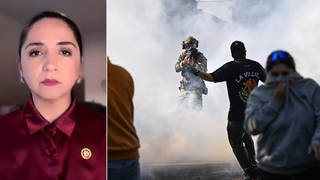
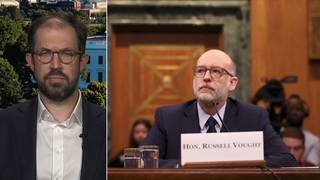
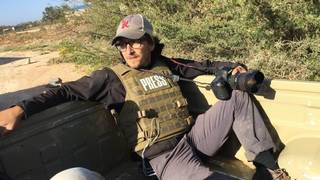
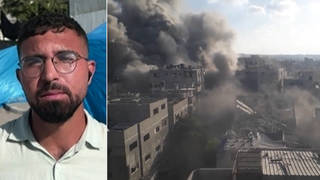





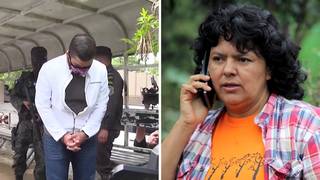

Media Options